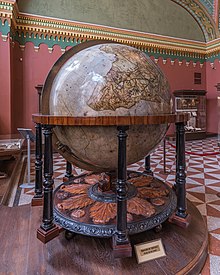State Historical Museum
The State Historical Museum ( Russian Государственный Исторический музей ) in Moscow is the most famous museum of national history in Russia . It is located in a building erected in 1883, which is architecturally strongly based on the old Russian architecture, in the center of Moscow on the northwest side of Red Square .
General

The museum is now considered the largest museum in the history of Russia . Its inventory includes a total of around 4.5 million exhibits from various subject areas and time periods.
There are 16 specialist departments, the archaeological department includes various finds on Russian territory from the Stone Age to the Middle Ages; In the precious metal department, products of Russian jewelry art from the 11th to the 20th century can be viewed; the numismatics department offers insights into a 1.7 million collection of historical coins, banknotes, medals and decorations, while the fine arts department houses around 500,000 paintings, watercolors, lubki , engravings, sculptures and photographs. There are also departments for wood products and furniture, Old Russian painting, cartography, book-making, metalworking, weapons, written documents, manuscripts (various collections, including the Synodal Collection ), glass and ceramics, fabrics, and a scientific archive .
In addition to the exhibition in the main building, the History Museum also includes the nearby St. Basil's Cathedral (since 1928), the Moscow Novodevichy Convent (since 1934) and the Lenin Museum (since 1993), which was opened in 1924, in the immediate vicinity of the main building was founded a few months after the death of the revolutionary leader and was one of the most ideologically important museums in the country during the Soviet era .
Several times a year, the museum also organizes special exhibitions that often go beyond the topics of Russian history. For example, from August to September 2007 a permanent exhibition dealt with the history, the present and the future of railway construction in Russia; from December 2006 to April 2007 there was an exhibition on love and eroticism in ancient art, and from July to October 2004 the museum hosted an art and history exhibition on the occasion of the 2004 Olympic Games.
History of the museum
The beginnings of the museum go back to 1872, when an organizing committee for the establishment of the first national history museum of the Russian Empire was set up in Moscow on the initiative of Count Alexei Uvarow and a few other nobles . Initially, the museum's exhibition consisted of the history-related exhibits from the Polytechnic Exhibition held in Moscow in 1872 . Under the name of the Imperial Russian Historical Museum , it opened on the day of the coronation of Tsar Alexander III. , on May 27, 1883, opened its doors to the public. At that time, the exhibition consisted mainly of archaeological finds up to the 12th century, which could be seen in eleven exhibition rooms.
In the years after the October Revolution of 1917, the museum was given its current official name, and several previously independent museum complexes (including St. Basil's Cathedral ) were incorporated into the Historical Museum. Over the decades, the museum's holdings have been greatly expanded; Among other things, by taking over the objects from the liquidation of several smaller museums (including the Rumyantsev Museum ). With a presidential decree from 1991, the State Historical Museum was declared a "particularly valuable object of the cultural heritage of Russia". 1986–1997 the museum was restored and was closed during this time.
Museum building
Since its opening, the majority of the exhibits have been in the building at the northwest end of Red Square . This house was built in the years 1875-1883 based on a design by the architect Vladimir Sherwood . Since it was specially designed for the Russian Historical Museum, according to the architect's plans, the exterior design of the building should reflect the diversity of historical Russian architecture. This can be seen in the dark red brick building to this day: With its facades, which are strongly reminiscent of Old Russian architecture and several pointed towers reminiscent of the towers of the neighboring Kremlin , the main building of the History Museum is one of the most famous historicist houses in Moscow. A few years after its completion, it partially served as a model for the GUM department store , which was also built in the immediate vicinity in 1893, which is also strongly historical . The interior of the Historical Museum was also very artistically decorated, with the exhibition halls painted by renowned artists such as Viktor Wasnezow and Ivan Aivazovsky .
Web links
- Official Website (Russian)
Coordinates: 55 ° 45 ′ 19.1 ″ N , 37 ° 37 ′ 4 ″ E


